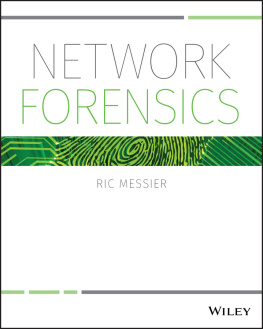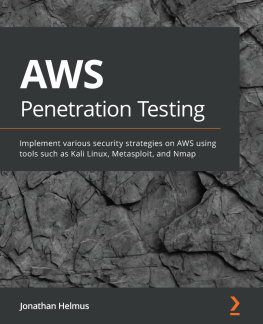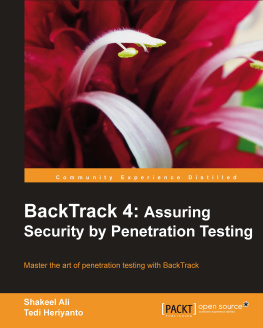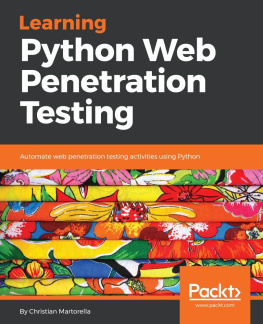1. What Is Penetration Testing?
Penetration testing is an art. You can learn a lot of techniques and understand all of the tools, but the reality is that software is complex, especially when you start putting a lot of software systems together. Its that complexity that means that there is no one-size-fits-all solution when it comes to finding ways to get into systems. An attack that may work against one Web server may not work for the same Web server running on a different system. Sometimes, you can try a particular attack a number of times without success before it suddenly starts working and you find a way to break into the system. A skilled and successful penetration tester has not only the technical skills necessary to run the tools and understand what is happening, but also the creativity necessary to try different approaches.
You may hear penetration testing referred to as ethical hacking . In fact, there are some professional certifications that include ethical hacking in the name. They are essentially the same thing, though ethical hacking includes a component in the name that penetration testing doesnt. Ethics is an important component when it comes to penetration testing. The name says it all, after all. You are testing to see if you can penetrate system and network defenses. If you can penetrate, you gain some level of access. In the course of normal operations, this may be access you may not otherwise have, and this is where ethics come in, though in reality the ethical component is more of a legal requirement.
The laws in the United States, and in many other countries, make it illegal to obtain unauthorized access to computer systems and networks. Once you have gained the access that is the point of a penetration test, you have broken the law. Unless, of course, you have permission to do it. While you may not have accounts on the systems in question, which would be explicit authorization, you should always have permission to perform the test, which is an implicit authorization to gain access to the systems. This permission is critical, and you may sometimes hear it referred to as a get out of jail free card. While technically its more of a stay out of jail card than a get out of jail card, the important word you dont want to overlook is jail . If you think you are doing someone a favor by testing their network or application security for them and that they will thank you when you find a serious hole, think again. Even years ago when everyone wasnt exactly on edge about computer security, this wasnt done by respectable professionals. Performing any sort of penetration testing or using the tools we are going to be reviewing against systems you dont have an agreement in place to touch has the potential to land you in jail.
Breaking into systems can be fun and exciting, and some people really find solving the puzzle and getting in to be a bit of a high. There are a lot of ways you can get experience without testing on other peoples systems, however. Using virtual machine software like VirtualBox , VMWare , or Parallels , you can install a number of operating systems on a single computer system. In fact, I would strongly recommend getting some virtual machines up and running so you can try out some of the techniques we will be going over. At a minimum, you may want to have an installation of Kali Linux and a copy of Metasploitable 2. Kali Linux is a Linux distribution that was once called BackTrack . It contains a lot of security tools installed by default and can be used to perform penetration tests with whats in place in the distribution. Metasploitable 2 is an implementation of Linux that is designed to be exploitable. It includes versions of various services that are vulnerable to exploits and are available in the exploit framework Metasploit. A copy of an older Windows installation may not be a bad idea either, just to see what Windows attacks look like.
Information Security
Why do we perform penetration testing? Ultimately, the goal of a penetration tester is to help an organization improve their defenses in case a real attacker comes by to break in and steal information. This information can come in many forms. In the case of a business, it may be intellectual property. This is any information that the business relies on to set them apart from other companies. This may be patents, source code, or any other documentation about how the business is run. Other forms of data are banking information, credit card numbers, social security numbers, usernames, passwords, and especially anything related to health care. Attackers may be trying to steal any of that information, because it can be sold or used to gain additional access to other systems.
You will find I avoid the use of almost any form of the word hack . Hacking has a long and storied history that predates its application to computers by several decades. When I started using computers, hacking meant doing something really cool and interesting with a computer. A hack was the result of that hacking. These days, hack and hacking are apparently meant to suggest something else, but the way the media uses the words is very vague and it obscures what is really going on. For the most part, when you hear about a hack in the news, what you are hearing about is a crime. I find its best to call a crime a crime. If we are talking about the people perpetrating that crime, we are talking about criminals. In order to be very clear, you will be seeing the words attacker or adversary . These are the people who are trying to break into your systems. You will see the word attack used to indicate what they are doing. Its essential to remember that there is nothing cute or charming about what these people are doing. They are frequently well funded and well organized, and their activities are run as a business because they make a lot of money from them. Treat them as though they are armed and dangerous, because they are.
Organizations will spend a lot of time and resources trying to protect themselves from these attacks. They will implement firewalls to keep attackers out and intrusion detection systems to hopefully catch when someone gets through the firewall. They will also implement procedures within the organization to protect themselves from insider attacks, which are also common. This may include the requirement of strong passwords or perhaps multi-factor authentication, which may require the user to have something on them or even use something like a fingerprint in addition to using a username and password.
The thing that organizations are trying to protect against is vulnerability. A vulnerability is a weakness in a system. System , though, is a very vague term. By using the word system , in this case, we are not only talking about the operating system and applications that make your computer useful but also, in a larger context, all of the computers and network devices within the entire enterprise network. The organization will try to locate its weaknesses, or vulnerabilities, and either remove or reduce them. The process of trying to remove or reduce a vulnerability is called remediation . When you are trying to reduce the impact of a vulnerability being taken advantage of, you are mitigating the impact. So, in the process of managing vulnerabilities, you will hear the terms mitigation and remediation .
When you take advantage of a vulnerability, you are exploiting it. You will see references to exploits as we continue, which are specific techniques or even pieces of software that are designed to exploit a particular vulnerability. The point of an exploit may be to obtain system-level access, meaning the attacker can see and even control files, users, and services. Some of these actions require a higher level of access than a regular user may have. On Windows systems, you would say that you have administrator access. Under a Linux or Unix-like system, you may say that you have root or superuser access. The user root is the default administrative account on a Unix-like system, including Linux. If you are root, you can do anything on the system. If you are root and there is some action you cant take, there is probably something wrong.















